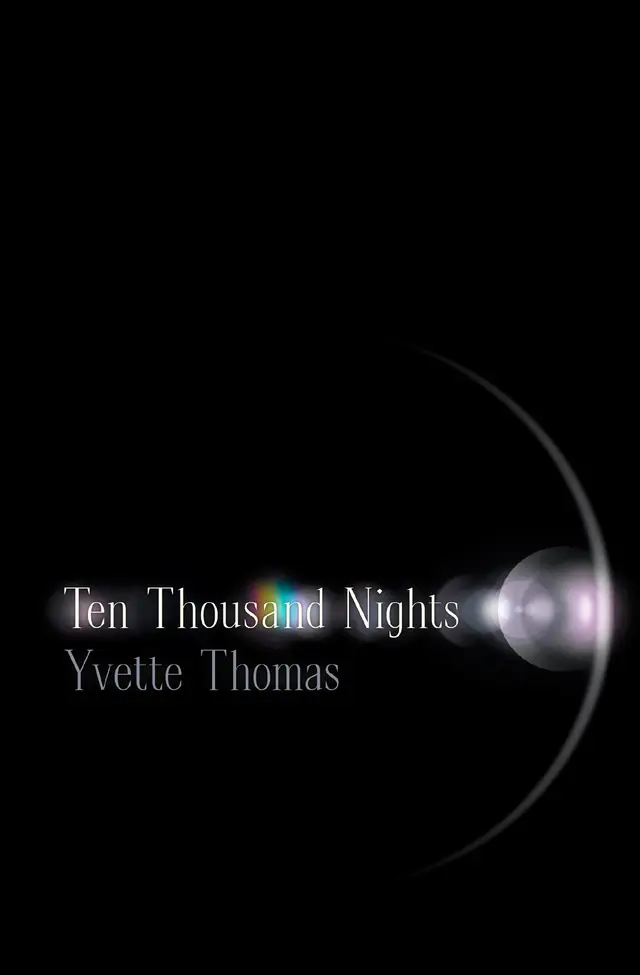In Ten Thousand Nights, Yvette Thomas’s debut collection, we meet a speaker who seems to teeter on the edge of life and death. This grants a delicious urgency to the work, and a perspective that shifts mercurially throughout the poems, many of which, unsurprisingly, are set in the threatening quiet of night.
The speaker of the title poem wonders, ‘what if one thousand nights remained, I wouldn’t make it to sixty’. But the poem returns to the domestic microcosm in which it began, just with a shift in tone: instead of hysterically slamming on a computer keyboard, the speaker hopes on her final day she’ll be able to ‘solve a crossword puzzle without cheating’. Life is precious, its length impossible to guarantee, its tiniest pleasures perhaps also its most significant.
The collection is host to several paeans to the natural world, its pace a contrast to the fragmented, hyper-scheduled nature of modern human living. In ‘Tui’s Tongue’, Thomas spells this contrast out:
Your brush-tipped tongue
finds nectar in a flower;
takes it to another,
feathers dusted in pollen.
No adrenaline rush
or disconnected thoughts,
no need to get anywhere
by 9 a.m.
This love for nature, its creatures and the simpler way they move through the world, more present in the lyrical pieces of Ten Thousand Nights, is offset by a host of sharply specific narrative poems. It’s in these that Thomas does her best work. ‘While Walking’ is one of these, a prose poem which in its comma-spliced breathlessness gathers details like a snowball gathers more snow:
I am not ready to leave my life, when that day arrives, I wish there was more talk about it, I know it is morbid but we tend to avoid it, I have no God to give me solace, He was put forward when I was a girl, his white linen robe, his leather sandals, his long grey beard, but I could not accept what those Irish nuns tried to teach me and no one has convinced me since
It’s as though Thomas’s voice is unlocked in these prose passages. Without restraint of line or obedience to form, all that is most urgent, most serious to the speaker in the moment, rises to the surface. In these pieces, the speaker’s memories and anxieties are forming and reforming and sparking against each other. The pair of poems in the middle of the collection, ‘Where We Did It’ and ‘When We Did It’, have the same kind of candour, tempered by concreteness:
in knee-high goosegrass on a far-flung island
between train tracks on the outskirts of Verona
in a Bavarian forest by a gravestone
enrobed in stinging nettles
Thomas takes care to be as accurate as possible with the details she includes. Time and place and characters, when they’re present, are fully formed and bear the grit of something totally real. The speaker imagines ‘stand[ing] beside the frozen pies’ with a former lover and eyes the ‘double bowline knot’ securing an old swing to a kowhai limb. This vivid immediacy is lost slightly in the more discursive pieces, which aren’t quite specific enough to offset their straightforwardness. Nevertheless, the collection blooms with warmth, and when Thomas writes, ‘You must understand: / I cherish my mother. / I want to look out for her, / to be her protector’, it’s hard to scorn her earnestness.
Thomas’s speaker loves life, not despite but because of its transience. She loves her family, her mother, her sons, and she cannot always hold them close. This is a confident debut collection that strikes a nuanced balance between the gift of living and the bitterness of loss.
The Anatomy of Sand is Mikaela Nyman’s third collection and her first in English. Nyman’s preoccupations, much like Thomas’s, are with the natural world and the ephemerality of its loveliness, though there is less of the domestic and familial here and a broader ecological and political scope as the poet chronicles specific landscapes across Aotearoa and the threats posed to them by extraction, chemical damage and sea level rise.
The collection’s first two lines introduce a sense of expansiveness that the poet carries through the entire book: ‘There’s a huddle of windblown seafarers here, at the edge / of the universe’. There’s room in The Anatomy of Sand for Finnish folklore, a prose collage of milk disposal methods, meditations on Covid-19-imposed distance and longing and an ode to a lost friendship. We travel from Svalbard to Porirua, from outer space to the shoreline of Taranaki.
Yet, Nyman never makes us feel as though we’re in a hurry. The Anatomy of Sand is worth treasuring for the way it slows time right down. Its poet invites us to sit down with her on the sand, to wonder and to mourn alongside her. There’s a slackness to much of her syntax — though these poems are usually organised into conventional sentences, there isn’t much punctuation. Instead, enjambment moves us through each poem at a more meandering pace as images unfurl from other images. Here we are, the poet says, caught in the midst of pockmarked wonder: let us take our time with it.
Lean in, as though the eye
of the tarn were a portal
to the world
—peat liquid, cloud tousle, tussock fringe
There’s a range of structural approaches throughout the collection. Some poems are split into numbered sections, working their way through discrete fragments attached to the same theme; others are arranged in regular couplets; others range across the whole page. Nyman uses space skilfully, allowing lines to range across each page as the composition of each scene falls into place. In ‘A pocket full of sand dollars’, one of Nyman’s experiments with found text aided by Gregory Kan’s text randomiser tool LEAVES.GLASS, lines tumble over themselves and swallow each other up, mimicking even in their shape on the page the formations and transformations of sand dunes:
Dunes are shaped by the low pressure space and deposit
sand on dunes behind the winds to swerve inland and
carried over the dunes is sucked up on their crests
and carried over the dunes. Along a beach, the fortune.
The momentum of some poems feels in step with the pace of the natural world with which they’re concerned. Gazing upon ‘the sunbleached arch / of this whalebone church’, we can sense the grand scale of natural history and the majesty of a world that’s home to creatures this huge: ‘the largest being / on our planet // carries the heavens / a world gone by’.
Nyman’s collection deals not only with the beauty of this environment but with how much of it we have already lost. There is grief and ugliness swirled in with the wonder. Pilot whales are lost in ‘murky waters’, the Ōpunake coast is ‘marred by disembodied limbs / of oil rigs’ and ‘we’re creating our own great stink […] / forcing iwi to place a rāhui over the Mimitangiatua awa’. Nyman takes care to relate specific details of these threats to the environment, her collection at certain points reaching beyond the realm of poetry into that of science communication, at points prioritising accuracy over rhythm, though never veering into didacticism.
Who does the sand belong to anyway?
Trans-Tasman Resources had their eye
on extraction of vanadium-rich iron ore
off the coast of South Taranaki
50 million tonnes of sand per year
a bay hollowed out. The Supreme Court
said no, echoing locals and iwi
In these two collections, Nyman and Thomas are attentive to the natural world, not simply laying their written description on top of it but sometimes also finding the echoes of written language within it. For Thomas, wave clouds are ‘a row of giant white / question marks’, while for Nyman, quails are ‘a running row of exclamation marks’. Nyman’s collection opens with an epigraph from Rachel Carson’s environmental science classic, Silent Spring: ‘In nature, nothing exists alone.’
It’s fitting, then, that Thomas’s collection includes a poem titled ‘Song of Silent Spring’ — confirmation that nature writers don’t exist in isolation either. Their conversation with all that is growing and decaying is also a conversation with each other, with writers who laid the groundwork, and with an uncertain future, burdened with the work of retrieval, conservation, and consolidation of loss.
Regarding the future: neither poet claims any power to predict it. Though we may seem to be following a linear path carved by human greed and destruction, Thomas closes her collection by reminding us of a different pattern: circularity on a cosmic scale, ‘each eclipse / like a glorious resurrection.’ Meanwhile, Nyman warns us how flawed our methods of prediction are: ‘Our technological fortress is built on a waning moon, / our sense of control but a chimera.’




